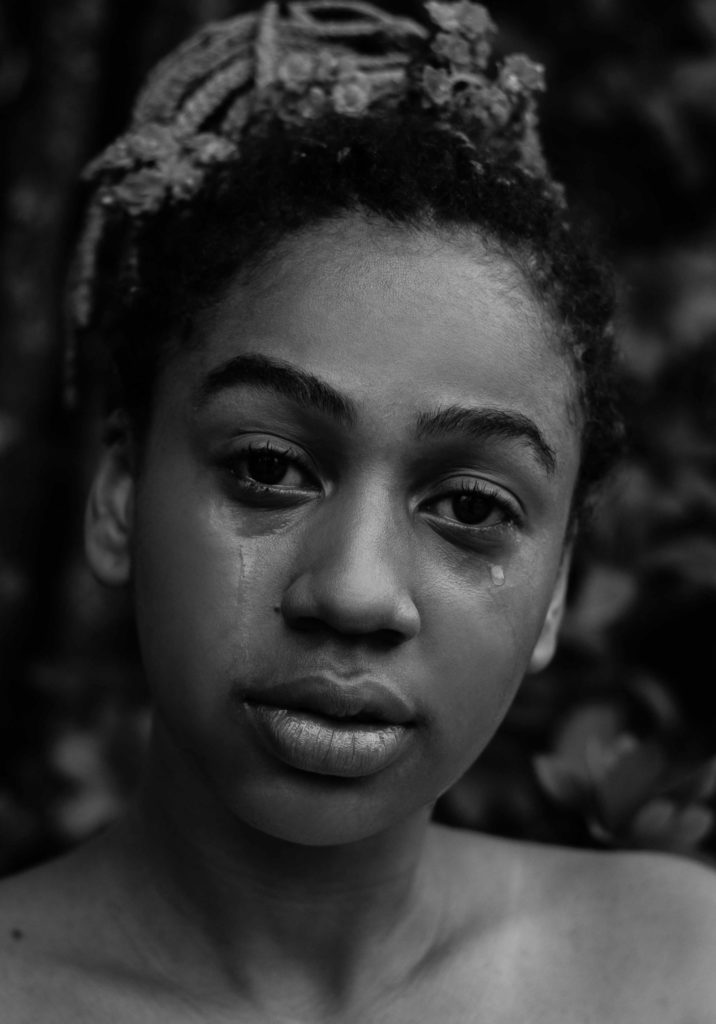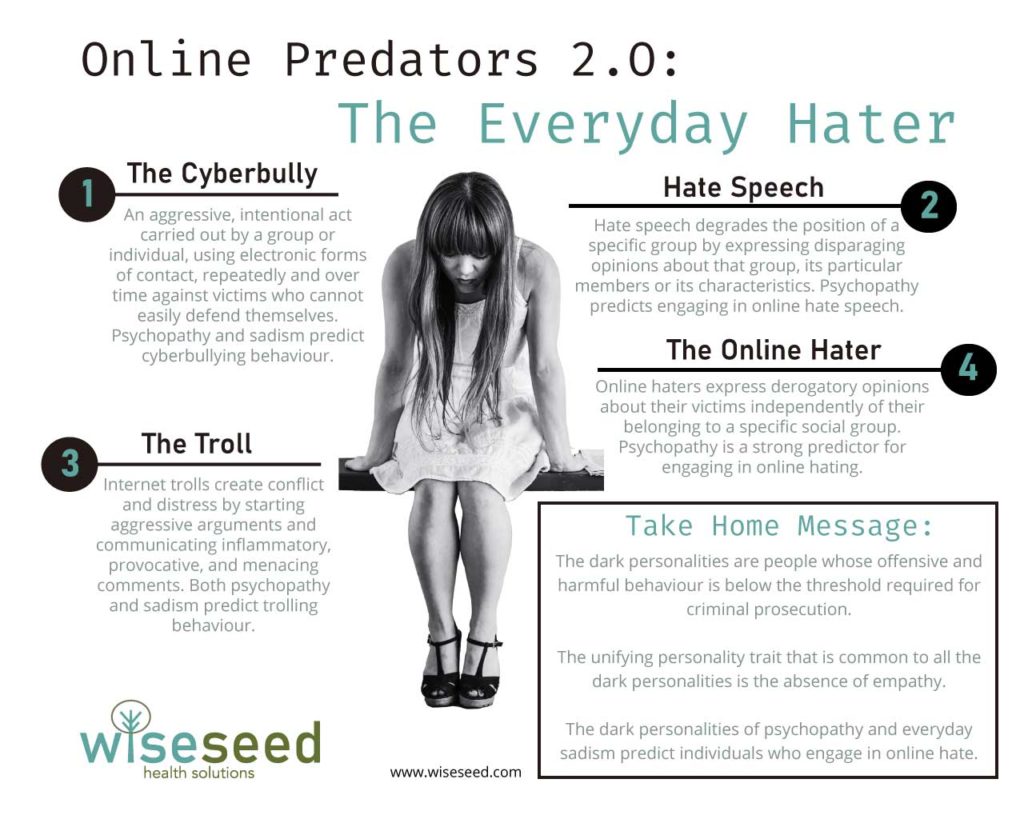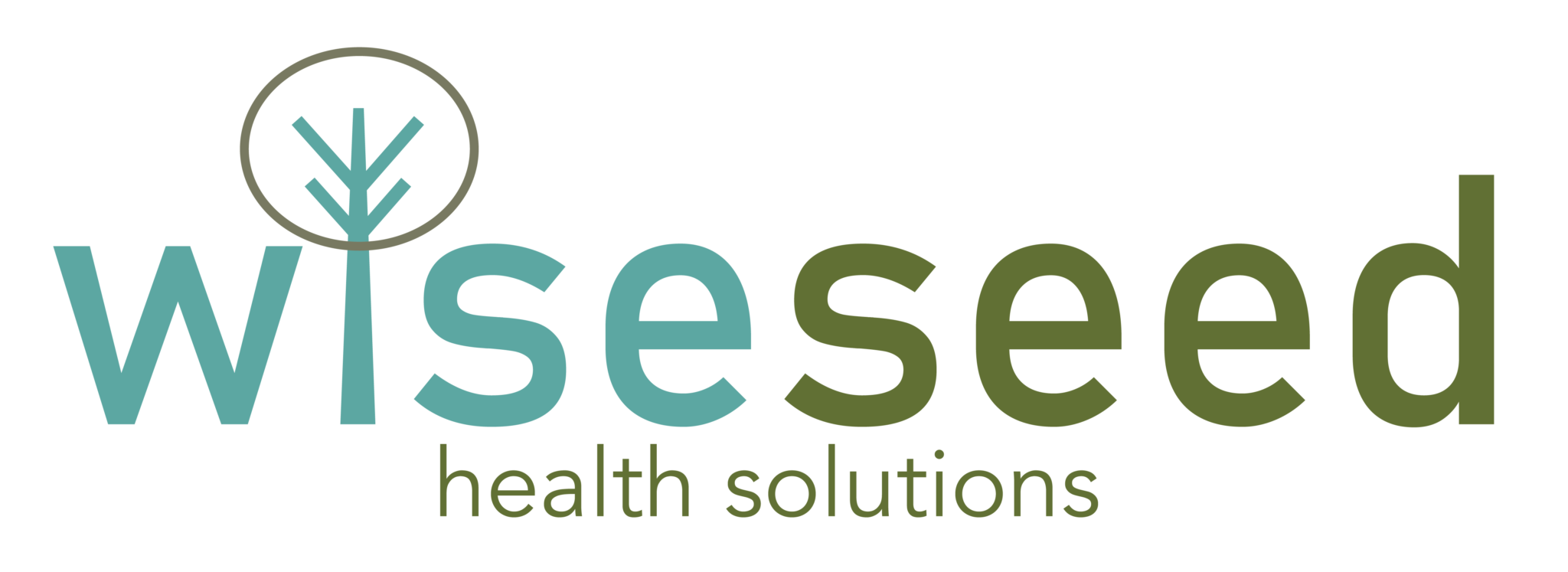Online Predators 2.O: The Everyday Hater

The Rise of the Everyday Hater
Online hate is on the rise 1. While the type of extreme online hate that leads to acts of terror such as mass shootings has rightfully received much attention 1, the low-grade online hate culture, perpetrated by what we call the everyday hater, continues to fester and grow unabated.
Unfortunately, it’s our kids who are most vulnerable to the toxic effects of the everyday hater. In this article, we examine the negative effects of online harassment on adolescents and young adults. Then, we explore the psychological makeup of the everyday haters who are targeting our children on social media.
The Alarming Rise in Depression within Adolescents
As we can all likely recall, adolescence is a critical time for our intellectual, psychological, and social development. It can be an amazing period in our lives. Still, there is also a sobering side when we acknowledge that adolescents are especially vulnerable to the development of depression 2. Evidence suggests that teenagers who experience depression are at higher risk of suffering from depression for the rest of their lives 3. Thus, reducing an adolescent’s experience of depression is a powerful approach to reduce the potentially lifelong burden of mental illness 3.
Knowing this, we are extremely concerned about the alarming increase in depression, self-harm and suicide attempts that have occurred within the adolescent population over the past decade 4. This unexpected increase in depression and anxiety is experienced predominantly by teenage girls. For example, between 1991 and 2010, the percentage of teenage girls with high depressive symptoms held steady at around 17% 4. This increased rapidly from 2011 onwards to reach 30% in 2018 4. In contrast, the increase in serious depression in teenage boys increased only slightly, rising from 16% to 19% during the same period 4.
The upswing in adolescent depression was reflected in corresponding increases in teenage self-harm and suicide. The emergency department admissions for self-harm in girls aged between 10-14 years old tripled between 2010 and 2015 4. Emergency department admissions for attempted and completed suicides among adolescents also rose during this period, again primarily by teenage girls 4.

The Not-So-Coincident Rise of Social Media
As the frequency of adolescent depression rose, so too did internet use 5. The use of the internet by adolescents, particularly social media and online gaming, has risen dramatically since 2009, while the corresponding levels of reading and TV watching have plummeted 5.
Although internet use and adolescent depression strongly correlate, this correlation does not prove that one caused the other. However, there is strong evidence emerging from independent observational and experimental studies that clearly identify social media use as a key driver of depression and suicide in adolescents (reviewed in 4).
In this regard, the analysis of social media use in a cohort of eleven thousand 14-year-olds from the UK is particularly informative 6. This study revealed that greater social media use led to ‘online harassment, poor sleep, low self-esteem and poor body image’, which in turn triggered higher depression and anxiety in adolescents, particularly girls (Figure 1) 6.
The Pernicious Role of Everyday Hate
Although the study identified the key drivers of adolescent depression, it is the online harassment of adolescents that we find particularly worrying, for the following reasons.
First, online harassment reinforces the other drivers of adolescent depression (Figure 1). Such feedback loops are known to contribute to persistent depression 7, and they offer a plausible mechanism for the sharp increase in depression and self-harm that has been observed in teenagers and young adults.
Second, online hate has a well-established track record of increasing human misery. Children and young adults who have experienced cybervictimization are more likely to self-harm, exhibit suicidal behaviours, have suicidal thoughts, and ultimately attempt suicide 8. More broadly, online hate has led to an increase in hate crimes, mass shootings and other acts of terror, the recruitment of extremists, and threats to public figures (reviewed in 1).
Third, despite an active attempt by social media platforms to suppress online hate, they are losing the battle 1. This is because (1) the internet provides anonymity, with online haters able to run multiple anonymous accounts across multiple platforms; and (2) social media platforms having to tread a fine line between suppressing online hate and enabling free speech 1.
Because it is so challenging to identify and block individuals who blatantly espouse violent or criminal views 1, it is impossible to regulate the more subtle forms of online aggression that are endemic within adolescent social networks.

The Cast of Villains
So, who are the everyday haters?
The dark personalities are a group of anti-social and subversive personality types whose offensive and harmful behaviour is below the threshold required for incarceration or clinical intervention 9. Unfortunately for the rest of us, these individuals survive, and indeed often flourish, within everyday society 9.
There are currently four recognised categories within the dark personality family. Collectively, this group is known as the Dark Tetrad.
1. The Narcissist
The common personality traits of the sub-clinical Narcissist are a heightened sense of entitlement, uniqueness, self-importance, and superiority 10. Grandiose narcissism, the most easily recognised manifestation, presents as an aggressive and dominant personality 10. In contrast, the ‘vulnerable’ or ‘covert’ Narcissist manifests self-sabotage and victimhood to inflate their sense of entitlement, uniqueness, and self-importance 10.
2. The Machiavellian
The Machiavellian personality disorder is named after the Renaissance philosopher Niccolò Machiavelli’s, who argued for the strategic use of deception and manipulation for political and personal gain 10. Machiavellians are cunning manipulators who are indifferent to the negative effects that their cynical exploitation inflicts on others 10. The hallmark of the Machiavellian personality is the strategic use of flattery, lies, and manipulation for selfish personal gain 10.
3. The Psychopath
People within the community who score highly on psychopathic traits are cold individuals with low empathy, who demonstrate little to no impulse control or remorse 10. Psychopaths routinely use aggression, intimidation and often violence to achieve their self-centred goals 10.
4. The Everyday Sadist
Individuals who present with subclinical manifestations of sadism have been termed everyday sadists. The everyday sadist will expend time and energy to inflict harm and suffering on the innocent 10. Indeed, the everyday sadist takes pleasure in doing so. This trait separates the everyday sadist from the psychopath. Whereas the psychopath inflicts harm and suffering to achieve their selfish goals, for the everyday sadist, inflicting harm and suffering is the goal.
| Feature | Narcissism | Machiavellianism | Psychopathy | Everyday Sadism |
| Callousness | High | High | High | High |
| Impulsivity | Moderate | Low | High | Low |
| Manipulation | Moderate | High | High | Low |
| Criminality | Low | White Collar | High | Low |
| Grandiosity | High | Low | Moderate | Low |
| Enjoyment of Cruelty | Low | Low | Low | High |
The broad identifying features of each personality within the Dark Tetrad is summarised in Table 1. Note that the unifying trait that is common to all dark personalities is callousness, which is the lack of empathy 9. This means that all members of the Dark Tetrad are indifferent to the suffering they inflict on others 9.
The Relationship Between Everyday Haters and the Dark Personalities
1. Cyberbullying
Cyberbullying is defined as ‘an aggressive, intentional act carried out by a group or individual, using electronic forms of contact, repeatedly and over time against a victim who cannot easily defend him or herself’ 11. The problem of cyberbullying is widespread, negatively impacting 20-40% of youths 12. Cyberbullying takes many forms, including text messages, website postings, emails, pictures, video clips and comments 12. The intent behind cyberbullying is to harass, denigrate and ostracise the victim 12.

What separates cyberbullying from other forms of antisocial online behaviour is that cyber-bullies are often known to their victims in real life 12. The harassing behaviour involved in cyber-bullying is often direct and specifically targeted 12. The negative consequences for the victims of cyberbullying include depression, anxiety, and alcohol dependence 12.
Two studies examined the relationship between the Dark Triad of narcissism, psychopathy and Machiavellianism with cyberbullying 12,13. Both studies concluded that psychopathy was the key predictor of cyberbullying 12,13. However, a recent study that included everyday sadism found that everyday sadism was also a key predictor of cyberbullying in senior high school students 14.
2. Hate Speech
Hate speech expresses contempt and degrades the position of a specific group (for example, a particular race, gender, or sexual orientation) by expressing disparaging opinions about that group, its particular members or its characteristics 15.
Only a single article has examined the relationship between the Dark Triad (i.e. Narcissism, psychopathy, and Machiavellianism) with hate speech. This study found psychopathy is the greatest predictor of online hate speech 16.
3. Trolls
Internet trolls create conflict and distress by starting aggressive arguments and communicating inflammatory, provocative, and menacing comments 17. The goal of the troll is to deliberately provoke, disrupt, and upset their victims 17.
There are four fundamental characteristics present in trolling behaviour: deception, aggression, disruption, and success 17.
Deception: People who engage in trolling usually portray themselves differently on their ‘trolling profiles’.
Aggression: By employing malicious taunts and provocative comments, trolls annoy or emotionally provoke others into retaliating.
Disruption: Individuals who engage in trolling employ meaningless disruptions aimed at attention-seeking and/or generating reactive responses from their victims.
Success: Individuals who engage in this behaviour are motivated by their success in deceiving, aggravating, and disrupting the people they troll.
It is the characteristics of deception and meaningless disruption unique to trolling that distinguishes online trolls from cyber-bullies 17.
Multiple studies have identified the dark personalities of everyday sadism and psychopathy as the strongest predictors of trolling behaviour 12,17-19
4. Haters
Online haters express derogatory opinions about their victims independently of their belonging to a specific social group 20. Online haters do not express disparaging opinions about a social group or race. Instead, online haters make personal attacks against their victims.

It is the absence of group discrimination that distinguishes online hate from those engaging in hate speech 20. Usually, the online hater is anonymous and does not know their victim personally, whereas the cyberbully and their victim are usually known to each.
The single study that examined the Dark Triad of narcissism, psychopathy, and Machiavellianism with Online Hate identified psychopathy as the strongest predictor of online hating 20. It’s currently not known to what extent everyday sadism contributes to online hate.
| Online Harassment | Predictive Personality Trait |
| Cyber Bullying | psychopathy, everyday sadism |
| Hate Speech | psychopathy |
| Trolls | psychopathy, everyday sadism |
| Haters | psychopathy |
Everyday Haters Can be Anyone
Given the cultural cliché of the unattractive male living in his parent’s basement while wreaking online havoc, it’s tempting to point the finger at men for the majority of online harassment. However, while men are slightly more inclined to express dark personalities than women, the difference is not large 21. Thus, for practical purposes, it’s reasonable to assume that there are roughly the same number of females and males with dark personalities within the general population 21.
Further, evidence suggests that adolescent girls are more likely to engage in online harassment than adolescent boys. For example, within the UK Millenium cohort study, 16.2% of girls were perpetrators of online harassment compared to 13.6 % of boys 6. Also, sex is not a predictive factor for posting online hate, although males do appear more inclined than females to engage in trolling and hate speech 21.
The bottom line for parents, educators and the victims of harassment is that online harassment is not the sole purview of the toxic male: Toxic females also partake.
Conclusion: We Need to Build Resilient Kids
The evidence is mounting that the dramatic shift of adolescent engagement with social media has caused an alarming increase in depression, self-harm, and suicide, particularly in young girls. The question is, what to do about it?
Unfortunately, we can’t turn to the social media platforms for an answer, because they have tried and failed to control online hate. Neither can we appeal to the better nature of the online user, because many everyday haters are psychopathic and sadistic. Finally, it’s unwise to ban adolescents from social media altogether, because such an act is likely to lead to social isolation and further depression in vulnerable adolescents.
Our conclusion is that we must increase the resilience of our children. We believe that resilient kids are better able to navigate social media and weather the storm of online harassment.
Towards this goal, we are actively investigating proven strategies for parents and educators to increase the resilience of the children and adolescents under their care. We’ll be publishing the fruits of our research in future posts under the banner of ‘Building Resilient Kids’.

Acknowledgements
We thank the artists Engin Akyurt, Mateus Souza, Gratisography and mikoto.raw at Pexels for their beautiful images.
References and Further Reading
1 Johnson, N. et al. Hidden resilience and adaptive dynamics of the global online hate ecology. Nature 573, 261-265 (2019).
2 McLaughlin, K. A. & King, K. Developmental trajectories of anxiety and depression in early adolescence. Journal of Abnormal Child Psychology 43, 311-323 (2015).
3 Johnson, D., Dupuis, G., Piche, J., Clayborne, Z. & Colman, I. Adult mental health outcomes of adolescent depression: A systematic review. Depress Anxiety 35, 700-716, doi:10.1002/da.22777 (2018).
4 Twenge, J. M. Why increases in adolescent depression may be linked to the technological environment. Current Opinion in Psychology 32, 89-94, doi:10.1016/j.copsyc.2019.06.036 (2020).
5 Twenge, J. M., Martin, G. N. & Spitzberg, B. H. Trends in US Adolescents’ media use, 1976–2016: The rise of digital media, the decline of TV, and the (near) demise of print. Psychology of Popular Media Culture 8, 329 (2019).
6 Kelly, Y., Zilanawala, A., Booker, C. & Sacker, A. Social media use and adolescent mental health: Findings from the UK Millennium Cohort Study. EClinicalMedicine 6, 59-68 (2018).
7 Wittenborn, A., Rahmandad, H., Rick, J. & Hosseinichimeh, N. Depression as a systemic syndrome: mapping the feedback loops of major depressive disorder. Psychological Medicine 46, 551 (2016).
8 John, A. et al. Self-harm, suicidal behaviours, and cyberbullying in children and young people: Systematic review. Journal of Medical Internet Research 20, e129 (2018).
9 Paulhus, D. L. Toward a taxonomy of dark personalities. Current Directions in Psychological Science 23, 421-426 (2014).
10 Moor, L. & Anderson, J. R. A systematic literature review of the relationship between dark personality traits and antisocial online behaviours. Personality and Individual Differences 144, 40-55 (2019).
11 Smith, P. K. & Slonje, R. Cyberbullying: The nature and extent of a new kind of bullying, in and out of school. In: Shane Jimerson; Susan Swearer and Dorothy Espelage, eds. The International Handbook of School Bullying. New York and Abingdon: Routledge, pp. 249-262. (2010).
12 Goodboy, A. K. & Martin, M. M. The personality profile of a cyberbully: Examining the Dark Triad. Computers in Human Behavior 49, 1-4 (2015).
13 Gibb, Z. G. & Devereux, P. G. Who does that anyway? Predictors and personality correlates of cyberbullying in college. Computers in Human Behavior 38, 8-16 (2014).
14 van Geel, M., Goemans, A., Toprak, F. & Vedder, P. Which personality traits are related to traditional bullying and cyberbullying? A study with the Big Five, Dark Triad and sadism. Personality and Individual Differences 106, 231-235 (2017).
15 Nockleby, J. T. Hate speech. Encyclopedia of the American constitution 3, 1277-1279 (2000).
16 Withers, K. L., Parrish, J. L., Terrell, S. & Ellis, T. J. The relationship between the “dark triad” personality traits and deviant behavior on social networking sites. Twenty-third Americas Conference on Information Systems, Boston (2017).
17 Buckels, E. E., Trapnell, P. D. & Paulhus, D. L. Trolls just want to have fun. Personality and individual Differences 67, 97-102 (2014).
18 Craker, N. & March, E. The dark side of Facebook®: The Dark Tetrad, negative social potency, and trolling behaviours. Personality and Individual Differences 102, 79-84, doi:10.1016/j.paid.2016.06.043 (2016).
19 March, E. Psychopathy, sadism, empathy, and the motivation to cause harm: New evidence confirms malevolent nature of the Internet Troll. Personality and Individual Differences 141, 133-137 (2019).
20 Sorokowski, P., Kowal, M., Zdybek, P. & Oleszkiewicz, A. Are online haters psychopaths? Psychological predictors of online hating behavior. Front Psychol 11, 553 (2020).
21 Paulhus, D. L., Buckels, E. E., Trapnell, P. D. & Jones, D. N. Screening for dark personalities: The Short Dark Tetrad (SD4). European Journal of Psychological Assessment (2020).
Disclaimer
The material displayed on this website is provided without any guarantees, conditions or warranties as to its accuracy.
Information written and expressed on this website is for education purposes and interest only. It is not intended to replace advice from your medical or healthcare professional.
You are encouraged to make your own health care choices based on your own research and in conjunction with your qualified practitioner.
The information provided on this website is not intended to provide a diagnosis, treatment or cure for any diseases. You should seek medical attention before undertaking any diet, exercise, other health program or other procedure described on this website.
To the fullest extent permitted by law we hereby expressly exclude all warranties and other terms which might otherwise be implied by statute, common law or the law of equity and must not be liable for any damages whatsoever, including but without limitation to any direct, indirect, special, consequential, punitive or incidental damages, or damages for loss of use, profits, data or other intangibles, damage to goodwill or reputation, injury or death, or the cost of procurement of substitute goods and services, arising out of or related to the use, inability to use, performance or failures of this website or any linked sites and any materials or information posted on those sites, irrespective of whether such damages were foreseeable or arise in contract, tort, equity, restitution, by statute, at common law or otherwise.

Ten Minutes is All You Need
Research has shown that ten minutes of moderate-to-vigorous exercise performed each day is enough to significantly reduce your risk of early death.
Sorry, we couldn't find any posts. Please try a different search.


